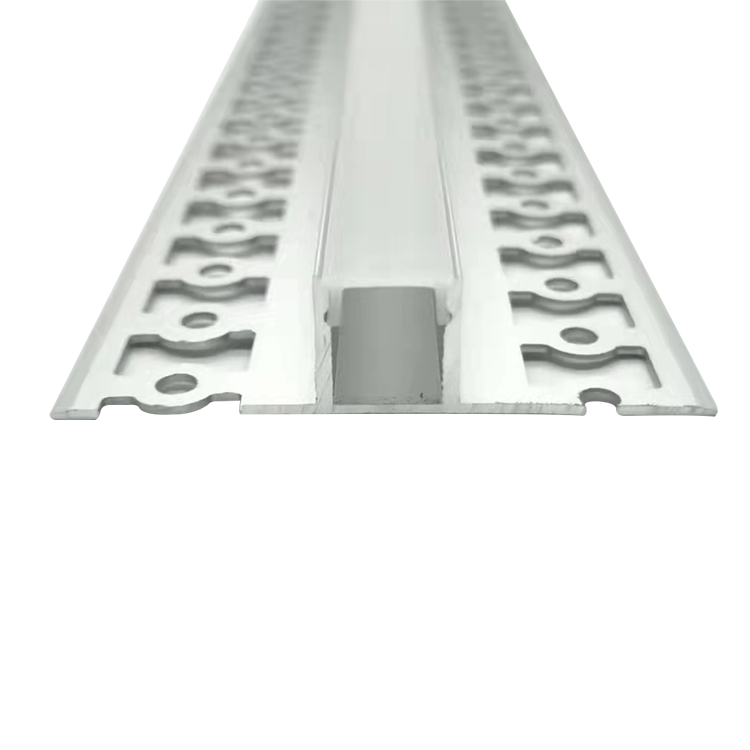Components of a Recessed LED Profile
2024-06-13
A recessed LED profile, also known as a recessed LED channel or extrusion, is a versatile and aesthetic way to integrate LED strip lights into various surfaces, creating seamless and professional lighting installations. These profiles are designed to house LED strip lights and can be recessed into walls, ceilings, floors, or furniture, offering a sleek and modern look. Here’s a detailed overview:
Components of a Recessed LED Profile
1. Aluminum Channel: The main body of the profile, made from aluminum, which serves as a heat sink to dissipate heat from the LED strip, enhancing its longevity and performance.
2. Diffuser Cover: A translucent or frosted cover that snaps onto the aluminum channel to diffuse the light, reducing glare and creating an even light distribution.
3. End Caps: These cover the ends of the profile, providing a finished look and protecting the LED strip from dust and moisture.
4. Mounting Clips/Brackets: Used to secure the profile in place within the recessed area.
Benefits of Using Recessed LED Profiles
- Aesthetic Appeal: Creates a clean, modern look by integrating lighting into surfaces without visible fixtures.
- Protection: Shields the LED strip from dust, moisture, and physical damage.
- Heat Dissipation: The aluminum channel helps dissipate heat, which can extend the lifespan of the LED strip.
- Light Diffusion: The diffuser cover ensures an even light distribution, reducing hot spots and glare.
- Customizable: Available in various shapes, sizes, and finishes to suit different design needs.
Applications
- Residential: Under-cabinet lighting in kitchens, recessed ceiling lights, staircase lighting, and in furniture for ambient lighting.
- Commercial: In offices, retail spaces, hotels, and restaurants for accent lighting, pathway lighting, and creating visually appealing environments.
- Architectural: Highlighting architectural features, coves, and niches.
Installation Process
1. Planning: Determine the location and length of the LED profile. Ensure the recessed area is appropriately sized to accommodate the profile.
2. Cutting: Cut the aluminum channel and diffuser to the required length.
3. Mounting: Use mounting clips or brackets to secure the channel in the recessed area.
4. Inserting the LED Strip: Place the LED strip inside the channel, ensuring it adheres properly.
5. Attaching the Diffuser: Snap the diffuser cover onto the channel.
6. Connecting the Power: Connect the LED strip to the power supply and controller, if used. Ensure connections are secure and insulated.
7. Finishing: Attach end caps to the profile for a finished look.
Choosing the Right Recessed LED Profile
1. Profile Size and Shape: Select a profile that fits the dimensions of the recessed area and the width of the LED strip.
2. Diffuser Type: Choose between clear, frosted, or opal diffusers based on the desired light diffusion and appearance.
3. Heat Dissipation: Ensure the profile is capable of dissipating the heat generated by the LED strip, especially for high-power LEDs.
4. Installation Location: Consider profiles designed specifically for floors, walls, or ceilings, as they might have additional features like enhanced durability.
5. Aesthetic Considerations: Match the profile finish with the interior design for a cohesive look.
Example Products
- KLUS LED Profiles: Known for high-quality aluminum profiles with various designs for different applications.
- Lumilum LED Channels: Offer a range of recessed profiles with different diffuser options.
- Tech Lighting: Provides architectural-grade recessed profiles ideal for commercial and residential applications.
In conclusion, recessed LED profiles are an excellent solution for creating elegant, functional, and protected LED lighting installations. They offer numerous design possibilities while ensuring the longevity and performance of the LED strips.



